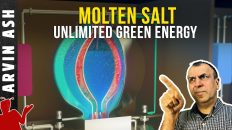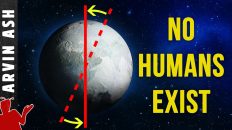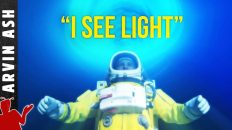How evolution actually works. Evolution explained simply.
——————-
In 1859, an apocalypse of biblical proportions occurred in the western hemisphere. This was not the kind of apocalypse you might imagine. Nothing physical was destroyed. But the destruction of conventional intellectual, social, and religious thinking was equally apocalyptic.
So what happened in 1859? A book called “On the origin of species by means of natural selection” was published by Charles Darwin. And the world has never been quite the same. We don’t realize today how this impacted society of the time, but suffice it so say that 160 years later, we are still affected by it.
Charles Darwin changed the way people look at living things. Most western society at the time had believed the biblical account of creation, before this intellectual earthquake.
Today evolution is one of the most tested, well-established theories backed by solid evidence in all of science.
Yet, it remains one of the most misunderstood. Here are some common statements you will hear:
– Evolution makes organisms change to better suit their environment
– Evolution occurs by random chance and mutations
– Humans are the most evolved species
– Evolution is just a theory so it’s speculation
– If humans came from monkeys, there wouldn’t be any more monkeys
– Thermodynamics disproves evolution
Why are all these statements incorrect? How does evolution actually work, and Why do so many people get it wrong? This is one of the most important topics in all of science in my opinion.
First let’s define evolution. Evolution is inherited change in a population of organisms over time resulting in appearance of new forms, under the influence of pressure from the environment.
The first thing to note is that changes are in populations not individual organisms. So for example, if an elephant finds itself living in a very cold climate for a long period of time, it will not become hairy like the extinct wooly mammoth in its lifetime. But over successive generations, the environmental pressure will likely cause hairier variations of the same breed of elephant to have a survival and reproductive advantage.
So subsequent generations will likely get hairier because those hairier elephants in the population are likely to have more opportunity to reproduce. Their offspring will have inherited the hairy trait. The change would occur in the population over time, not the individual, and not suddenly.
Another point to note is that this change does not occur by random chance. Natural selection is the opposite of random chance. It is driven by a survival and reproductive advantage. And these changes in populations are not typically caused by sudden beneficial random mutations either. Mutations are caused by mistakes that happen when a cell makes a copy of its genetic information during the cell division process. Mutations are random but they are driven by a non-random process called natural selection. And mutations do provide a critical source of variation in the gene pool of large populations. But the vast majority of these genetic mistakes are either neutral or harmful. It is estimated that only about 0.01% are beneficial, meaning 99.99% of all mutations are neutral or harmful. But even this small amount of 0.01% is enough to be a significant driver of evolution because it generates the genetic variation on which natural selection can act.
Any variation that makes an organism more “fit” for survival is more likely to spread in the gene pool through through this process. But this idea of fitness does not mean that the strongest survive. A better fit organism does not mean that bigger, faster, more ruthless, smarter or stronger individuals are favored. Only individuals that have a better chance for survival and reproduction are favored. Strength, size, ruthlessness, or intellect does not equal “more fit.”
Ultimately, evolution is not goal oriented or a linear process towards some kind of “progress.” It is simply about fitting best in one’s environment, and having the opportunity to reproduce.
Some organisms may not change over long periods of time. Take the example of the American Alligator. The fossil record indicates that it has stayed largely the same for 8 million years. If there are no major changes in the environmental conditions, and if a species is already well suited for life in those conditions, why would it change?
Also, the idea that humans are the most evolved species because we are cleverer, or faster, or have more nuclear bombs than any other species is plain wrong. If you think you are superior to a Tuna, try living under water for 40 years.
Humans are not the most successful species on the planet. Our planet is dominated by single celled organisms. There are 10^30 single celled organisms weighing 10^14 kg. The weight of all humans is 10^11 kg. If you go by weight then even insects are more successful than us, weighing 300x more than all humans combined.
What about the idea that evolution is only a theory? Or the idea that evolution is like religion, that it is about faith and not evidence.
First, in science, a theory is not simply a hypothesis meaning a speculative and unprovable idea. In science, theories are well-supported explanations. A theory means that it is “a model capable of being tested by experiment or observation, and able to predict future observations of the same kind.” It is based on a careful and rational examination of the facts.
Calling something “a theory” is a good thing. not a bad thing in science. So, if someone says that evolution is only a theory, ask them if they know what a scientific theory actually is. We have the theory of relativity and the theory of gravity too, which are also very robust.
Evolution has properly predicted results and observations that we see taking place. No evidence is able to stand up against it, and all the evidence supports it. That is why the scientists support it. It is still called a theory because it is still subject to examination and confirmation.
One distinction should be made here when people say that evolution cannot explain how life started. That is absolutely correct. But that’s not the purpose of the theory of evolution. Evolution only works on populations of living organisms. How life first started is called abiogenesis, and it is not well understood like evolution is. I made a video about that if you want to know more about it.
Then there is the statement, if we evolved from monkeys, why are there still monkeys. First, we did not evolve from monkeys. We did not even evolve from gorillas or chimpanzees. Rather, evolution shows that we share a common ancestor that lived probably around 10 million years ago. This ancestor was not a chimpanzee or gorilla, but just a common ancestor to all modern apes, including us. Go back further about 25 million years ago, and this common ancestor of ours, shared a common ancestor with modern monkeys that live in Africa and Asia today. So that 25 million year old ancestor is our ancestor too. In fact, if you go back far enough, all living things on earth have a common ancestor. We are even related to all plants, mushrooms, and bacteria.
Finally, we get to the idea of the laws of Thermodynamics, namely entropy, disproving evolution. The idea here is that evolution cannot be correct because it defies a fundamental law of physics, that entropy or disorder increases over time, whereas complex life appears to be a drive towards more and more order.
Astronomer Chandra Wickramsinge famously told a court in 1981,“The chances that life just occurred are about as unlikely as a typhoon blowing through a junkyard and constructing a Boeing 747,”– This proves that even highly intelligent, science-educated people can totally misunderstand and mischaracterize evolution.
A slightly better analogy would be something like this: Start with a million junkyards, put a tornado through each. Exhaustively test the wreckage left after each one to find the most flight worthy object. Make a million exact copies of that most flight worthy combination of junk yard and object. Put another million tornadoes through it, run exhaustive tests to determine the most flight worthy object, make a million more copies of the junkyard and most flight worthy object. And keep doing this over and over millions of times, until you produce some kind of machine, may something simple and crude – that can fly. Then make millions of copies of that, and further refine for flight worthiness, and keep doing this over and over for millions of years. You will end up with something that might be even more flight worthy than a Boeing 747 – if the evolutionary driver is flight-worthiness.
If you pick even the simplest bacteria alive today and calculate the odds of getting their genome by randomly shuffling DNA sequences, the odds are astronomically small. But random shuffling is not the way evolution works.
The idea of entropy applies to closed systems. Put crudely, a closed system where matter and energy are conserved, gets more disorderly over time. The earth is NOT a closed system. The sun is spraying it with huge amounts of energy every day. This energy is driving the thermodynamics of the earth. Overall entropy is increasing of the closed system that contains earth and the sun, but this does not mean that pockets of lowering entropy cannot exist. Your refrigerator is making the food inside cooler, and decreasing the entropy of the food inside, but if you feel the vents outside that refrigerator, you will find that it is heating up your house. The entropy of your whole house if it was a closed system would be increasing.
To understand evolution, you need to appreciate three things. First, that quadrillion-to-one chances actually happen all the time. Secondly that, while mutation is random, which mutations survive is not random. It is a systematic process that results in adaptations over time, influenced by environmental factors. And thirdly, given enough time, the accumulation of one beneficial mutation after another can produce amazingly complex systems. Although the present day observational results of Evolution can appear to be impossible, it’s a process that – given enough time – and influenced by selection and other environmental pressures, makes the impossible extremely likely.
For the past 160 years, scientists have tested this in every imaginable way, from field studies, to fossil studies, to computer modeling, with every imaginable organism. Each new test has only added to the already overwhelming body of evidence to support this theory. There is not a single piece of credible evidence to disprove it. There is really not much in science that is as well proven. Famous genetist Theodosius Dobzhansky said in 1973, “Nothing in biology makes sense except in the light of evolution.”







